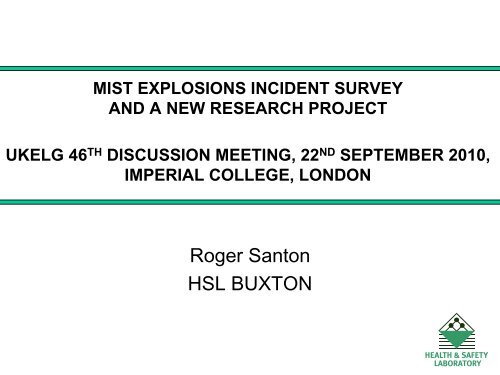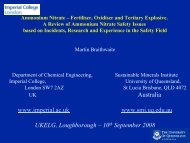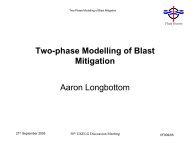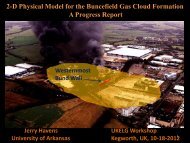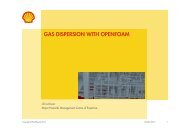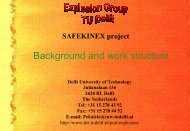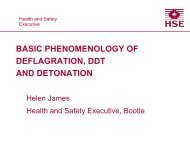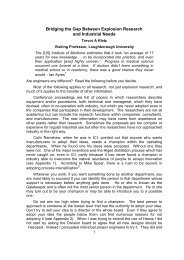The mist explosion incident review and a new joint-industry research ...
The mist explosion incident review and a new joint-industry research ...
The mist explosion incident review and a new joint-industry research ...
You also want an ePaper? Increase the reach of your titles
YUMPU automatically turns print PDFs into web optimized ePapers that Google loves.
MIST EXPLOSIONS INCIDENT SURVEY<br />
AND A NEW RESEARCH PROJECT<br />
UKELG 46 TH DISCUSSION MEETING, 22 ND SEPTEMBER 2010,<br />
IMPERIAL COLLEGE, LONDON<br />
Roger Santon<br />
HSL BUXTON
ATEX (user) Directive:<br />
“explosive atmosphere” means a mixture,<br />
under atmospheric conditions, of air <strong>and</strong><br />
one or more dangerous substances in the<br />
form of gases, vapours, <strong>mist</strong>s or dusts in<br />
which, after ignition has occurred, combustion<br />
spreads to the entire unburned mixture”
DSEAR ACOP, paragraph 145:<br />
“Some substances do not form explosive<br />
atmospheres unless they are heated, <strong>and</strong><br />
some liquids if released under pressure will<br />
form a fine <strong>mist</strong> that can explode even if there<br />
is insufficient vapour.”
Rolf Eckhoff [1]<br />
“Published reports on accidental spray or <strong>mist</strong><br />
<strong>explosion</strong>s, apart from crank case <strong>explosion</strong>s<br />
in ship engines, are scarce.”<br />
Similar comments in other references
• 2008 Literature survey carried out by HSE<br />
library services
Databases used:<br />
• Chemical Engineering <strong>and</strong> Biotechnology Abstracts<br />
• National Technical Information Service<br />
• Ei Compendex<br />
• Pascal<br />
• Tulsa World<br />
• Chemical Abstracts<br />
• MHIDAS – Major Hazards Data Incidents Service
• HSEline ( based on the HSE’s library catalogue)<br />
• Nioshtic <strong>and</strong> Oshline from the National Institute for<br />
Occupational Safety <strong>and</strong> Health (NIOSH) in the US<br />
• <strong>The</strong> Reyerson International Labour Occupational Safety <strong>and</strong><br />
Health Index, from the Ontario Ministry of Labour<br />
• Cisdoc, the database of the International Occupational<br />
Safety <strong>and</strong> Health Information Centre of the International<br />
Labour Organisation in Geneva.
• 23 relevant records detailing 33 <strong>incident</strong>s<br />
have been identified. In some cases, the<br />
<strong>incident</strong>s may have been large fires or<br />
<strong>explosion</strong>s. In all cases, the <strong>incident</strong>s arose<br />
from the ignition of <strong>mist</strong>, in most cases at a<br />
temperature near or below the liquid flash<br />
point.<br />
• For full details of the <strong>incident</strong>s, <strong>and</strong><br />
references, see the presentation from the 44 th<br />
discussion meeting on the UKELG website.
• 9 <strong>incident</strong>s alone responsible for 29 fatalities
Fuels<br />
Oils: Lube oil 5 <strong>incident</strong>s<br />
Transformer oil 1<br />
Vegetable oil 3<br />
Hydraulic oil 1<br />
Fuel oils 7<br />
Crude oil 3<br />
Heat transfer oil 4<br />
Kerosene 7<br />
Naphtha 4<br />
Butyl acrylate 2
Sources of Ignition<br />
Compression autoignition 1<br />
Electric arc 1<br />
Hot surface 3<br />
Static 6<br />
Combustion chamber/igniter/pilot flame 10<br />
Hot work 1<br />
Engine induction 1<br />
Catalyst 1<br />
Naked light 1<br />
Unknown 13
Conclusions<br />
• Insufficient data for realistic use in QRA.<br />
• <strong>The</strong> listed <strong>incident</strong>s are mostly in UK <strong>and</strong> USA,<br />
with a few in Europe. Whole world numbers will<br />
be higher.<br />
• <strong>The</strong> listed <strong>incident</strong>s are mostly those that were<br />
significant <strong>and</strong> worthy of report. Whole world<br />
numbers including less significant <strong>incident</strong>s <strong>and</strong><br />
near misses will be far higher.<br />
• <strong>The</strong> number of reported <strong>incident</strong>s is far higher<br />
than had been known. <strong>The</strong> hazard is very real <strong>and</strong><br />
must be taken into account in risk assessments<br />
<strong>and</strong> mitigation.
Conclusions<br />
• A further conclusion drawn from the<br />
presentations at the UKELG 44 th meeting was<br />
that the existing guidance on <strong>mist</strong> <strong>explosion</strong>s<br />
is clearly deficient. A <strong>new</strong> <strong>research</strong> project, to<br />
be <strong>joint</strong>ly funded by HSE <strong>and</strong> Industrial<br />
partners, has been developed to remedy this<br />
situation so far as possible.
OBJECTIVE<br />
• To develop practical guidance on:<br />
– <strong>The</strong> likelihood of the formation of<br />
flammable <strong>mist</strong><br />
– Mitigation measures<br />
– Area classification zone <strong>and</strong> extent<br />
– Protected equipment concepts, <strong>and</strong><br />
equipment selection
PROJECT STAGES
LITERATURE SEARCH<br />
• Large existing body of literature<br />
• No holistic model<br />
• Most recent major search was by Prof. Rolf<br />
Eckhoff in 1995<br />
• Further search will be carried out to ensure<br />
that all <strong>and</strong> any relevant more recent work is<br />
taken into account<br />
• Knowledge gaps to be identified
MIST GENERATION<br />
• Generic model to be developed from existing<br />
references if possible<br />
• Simultaneous alternative experimental<br />
programme
EXPERIMENTAL<br />
• Determine maximum safe pressure below<br />
which flammable <strong>mist</strong> formation is improbable<br />
for a range of fluids
EXPERIMENTAL<br />
• Range of fluids:<br />
– Lubricating oil<br />
– Vegetable oil<br />
– Hydraulic oil<br />
– Light fuel oil<br />
– Heavy fuel oil (at operating temperature)<br />
– Heat transfer fluid (at operating temperature)<br />
– Jet fuel<br />
– Naphtha<br />
– Kerosene<br />
– Diesel<br />
– White spirit
EXPERIMENTAL<br />
• Variables<br />
– Pressure<br />
– Hole size<br />
– Temperature<br />
– Hole roughness<br />
– Impingement<br />
• Ignition energy only so far as necessary to advise on selection<br />
of equipment<br />
• Flammable extent so far as necessary for area classification
• Flange guards<br />
• Mist detection<br />
• Double containment<br />
• ??<br />
MITIGATION
TIMETABLE<br />
• Stakeholders’ meeting-October 15 th 2010,<br />
HSL Buxton<br />
• Financial or other contribution commitments –<br />
November 2010<br />
• Project Jan 2011 – March 2012<br />
• Final report – Dec 2012
PROTECTED EQUIPMENT<br />
• No st<strong>and</strong>ard for design, testing, or<br />
certification against <strong>mist</strong> exposure<br />
• Guidance required
PROPOSAL<br />
• <strong>The</strong> detailed proposal is available from<br />
– HSL, from Bronwen Ley 01298 218835<br />
– R Santon - r.santon@btinternet.com


